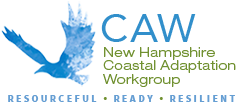By: Abigail Lyon, PREP & Nathalie Morison, NHDES Coastal Program
This year’s climate summit brought together 65+ people from around New Hampshire who represented state, federal, and regional agencies that provide financial support for climate adaptation and resilience projects across the region, as well as communities who shared their experience utilizing different funding mechanisms. Participants learned how important it is to think creatively in order to access existing programs and to work toward creating dedicated and sustainable funding streams for resilience in our communities. As is common when planning for climate change, the status quo will be insufficient to support projects into the future. Below are a few of the key takeaways from this year’s climate summit.
#1 | It’s time to think outside the grant funding box
It’s no secret that much of the resilience and adaptation progress we’ve made to date in New Hampshire has been in large part thanks to federal grants. We also know that federal grants are becoming increasingly competitive and this trend is likely to continue. In addition to thinking creatively about existing sources of funding, we heard from a number of speakers about the need – and a few examples of how – communities can work toward what we call SAFE funding sources. That is, those that are Sustainable, Adequate, Flexible, and Equitable. Dedicated funding will increase our communities’ self-reliance and long term ability to address the increasing impacts of climate change.
#2 | Utilize existing programs to diversify funding
Not ready to let go of grants just yet? That’s okay, too. Coastal resilience and adaptation efforts are likely going to require unique combinations of multiple funding sources. As we learned in the morning session, there are a number of grant and loan programs available (e.g., FEMA Hazard Mitigation Assistance Programs, NH Clean Water State Revolving Fund (CWSRF), and the NH Aquatic Resources Mitigation Fund) that have so much untapped potential to be used for resilience and adaptation. For example, did you know that the CWSRF now offers 100% principal forgiveness up to $75,000 for wastewater and stormwater planning evaluations, including vulnerability assessments? That is a game changer, in our opinion, for communities that have yet to complete more detailed, site-specific evaluations of their wastewater and stormwater facilities. Obtaining these resources is going to take creativity and planning. Don’t be discouraged if your project, as originally conceived, doesn’t appear to meet all of the application requirements. Sometimes it just takes framing what you want to accomplish through a different lens, or tweaking aspects of your proposal, so it achieves multiple benefits. It’s also never too early to think ahead about how you might want to phase your project(s) and the different funding opportunities available to fund each piece of the puzzle.
#3 | Help is available – all you need to do is call
Do you have a project in mind? Wondering how you can take advantage of existing programs? Can’t quite figure out how to navigate the application process? Curious about stormwater funding options? Want to learn more about your options for absorbing unexpected infrastructure repair costs? How about tax credits, transfer of development rights, and tax increment financing? If there’s one takeaway that sticks with you, we hope it’s this one. CAW and every single one of the presenters are here to help. To make your lives easier, we’ve compiled some key contact info below. So don’t wait, get in touch!
Helpful Contact Information
FEMA Hazard Mitigation Assistance: Alexx Monastierio, HSEM
NH Clean Water State Revolving Fund: Beth Malcolm, NHDES
NH Aquatic Resources Mitigation Fund: Lori Sommer, NHDES
Stormwater Funding: Deb Loiselle, NHDES
Municipal Planning Tools: Julie LaBranche, RPC | Kyle Pimental, SRPC
#4 | As 2020 approaches, reflect and set new intentions
It’s hard to believe, but CAW celebrated its 10th anniversary this year. Wrapping up the climate summit, Cory Riley reflected on how far we’ve come in the last decade; from learning about the challenges we face to hosting a climate summit on how we’re actually going to pay for solutions.
“We have spent 10 years as a community identifying [climate change] threats.
Today was the nitty gritty about getting this work done!”
– Cory Riley, Reserve Manager, Great Bay National Estuarine Research Reserve
We invite you to reflect on how far your community has come in the last decade and encourage you to renew or set new intentions about how your community will support adaptation and resilience projects over the next decade and beyond. Perhaps your goal for 2020 is to connect with one of the agencies or organizations listed above to talk about a potential project, or to reach out to CAW to learn more about ways you can support resilience in your community, or even to start exploring the creation of SAFE funding to support on-the-ground adaptation.
As always, CAW is looking forward to working with you towards on-the-ground implementation. We’re rooting for you…we’re here if you need us…and we’ll see you in 2020!
